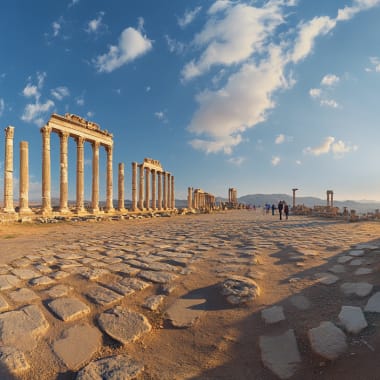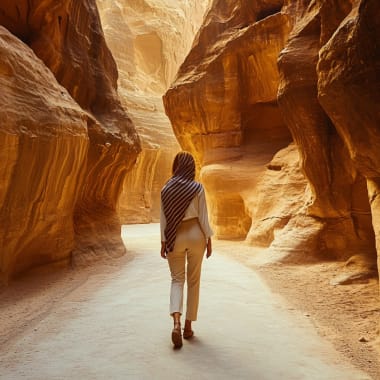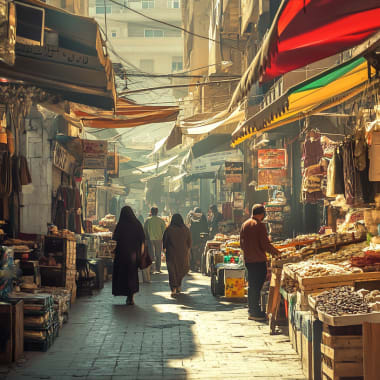
Top Sights in Jordan
From ancient wonders of the world to endless desert landscapes – discover the highlights of a fascinating travel destination.
From ancient wonders of the world to endless desert landscapes – discover the highlights of a fascinating travel destination.
Jordan is a country full of contrasts: Between desert and water, antiquity and the present, a wealth of unique places reveals itself, capturing the imagination of travelers. Whether it's a UNESCO World Heritage site, a biblical site, or a natural wonder – the kingdom by the Red Sea is full of stories and unforgettable impressions. In this overview, we present to you the most impressive sights that you should not miss during a trip to Jordan.
Petra – The Rose-Red City of the Nabataeans
A sandstone world wonder – hidden in a canyon, rich in history, myth, and magic.
What Makes This Place So Special
Petra is without a doubt Jordan’s archaeological crown jewel – a masterpiece of rock-carved architecture and a vivid reminder of a once-thriving ancient civilization. As the former capital of the Nabataean Kingdom, Petra played a key role in caravan trade between Arabia, Egypt, Syria, and the Mediterranean. The Nabataeans, skilled merchants and engineers, dealt in precious goods such as frankincense, myrrh, silk, and spices. Their innovative methods for collecting and storing water in the desert allowed them to build an independent and prosperous trade network.
Designated a UNESCO World Heritage Site in 1985, Petra is celebrated for its unique fusion of Hellenistic architecture and traditional Nabataean rock-cut tombs and temples. In 2007, it was named one of the New Seven Wonders of the World. Nestled among dramatic sandstone cliffs and winding canyons, this ancient city enchants visitors with its striking beauty and historical depth.
Experiences You Won’t Want to Miss
Exploring Petra is like stepping back in time. The most iconic structure is undoubtedly the Treasury (Al-Khazneh) – a 130-foot-tall façade carved into the rose-colored rock. Walking through the narrow Siq and catching the first glimpse of this wonder is a moment few travelers ever forget.
Equally impressive is the Monastery (Ad Deir), reachable by a steep but rewarding climb. The sweeping views over the surrounding mountains are unforgettable. Along the way, highlights such as the Royal Tombs and the Colonnaded Street offer insights into the scale and sophistication of Petra’s urban design.
One of the most magical experiences is Petra by Night, a candlelit event that takes place every Monday, Wednesday, and Thursday evening. More than 1,500 candles light the Siq and Treasury, transforming the site into a glowing spectacle of light and shadow. For a quieter visit, consider entering Petra via the lesser-known back route – a scenic and less crowded alternative.
Good to Know for Your Travel Planning
Getting to Petra:
- From Amman: The JETT bus departs daily from the Abdali Terminal (approx. 3.5 hours). Driving takes around 2 hours and 45 minutes.
- From Aqaba: By car, it’s about 1 hour and 35 minutes. Public transport usually requires a transfer in Wadi Rum and takes around 4 hours.
Getting Around:
Most of Petra is accessible only on foot, with some sections involving steep or lengthy hikes. Camels or donkeys are available to help with longer stretches, such as the climb to the Monastery or through the Siq – but be sure to agree on a fair price in advance.
How Much Time to Plan:
At least one full day is recommended – ideally two, if you want to explore the less-frequented areas at a relaxed pace.
Preparation Tips:
Wear sturdy, comfortable shoes and sun-protective clothing. In cooler months, bring an extra layer for early mornings. Don’t forget plenty of water, snacks, and sunscreen. The best times to visit are early in the morning or late afternoon to avoid both the heat and the crowds.
Wadi Rum – The Valley of the Moon
A cinematic desert landscape filled with adventure, Bedouin culture, and magical sunsets.
What Makes This Place So Special
Located in southern Jordan, Wadi Rum is one of the most breathtaking desert landscapes in the Middle East. Often called the "Valley of the Moon," it stuns visitors with towering sandstone formations, deep canyons, natural rock bridges, and sweeping red and orange dunes. Shaped over millions of years by erosion and tectonic shifts, the terrain is a dream for nature lovers, geologists, and photographers alike.
But Wadi Rum’s significance goes beyond its striking geology. For centuries, it has been home to Bedouin communities whose lives are deeply intertwined with desert traditions. Hospitality, respect, and a strong sense of community remain central values that visitors can still experience firsthand. The area also holds historical importance as the base of T. E. Lawrence—better known as "Lawrence of Arabia"—during the Arab Revolt in World War I. Landmarks like Lawrence’s Spring and Lawrence’s House pay tribute to his legacy and the region’s storied past.
Experiences You Won’t Want to Miss
There are countless ways to explore Wadi Rum, but one of the most popular is a 4x4 Jeep tour, which offers flexible access to the area’s most iconic rock formations, narrow canyons, and panoramic viewpoints. For a slower, more traditional experience, opt for a camel ride and soak in the silence and serenity of the desert. Hiking and rock climbing are also excellent options—especially for experienced adventurers seeking unforgettable views from high above the sand.
Many visitors consider a night in a Bedouin camp the ultimate highlight. Sitting around a campfire, sharing a traditional meal, and gazing up at a crystal-clear night sky creates a truly authentic desert experience. Nature lovers shouldn’t miss the rock bridges like Burdah and Um Fruth, narrow canyons such as Barrah and Abu Khashaba, or the glowing dunes around Jabal Khazali. And whatever you do, catch at least one desert sunset—when the golden light melts into deep red, the landscape becomes pure magic.
Good to Know for Your Travel Planning
Getting to Wadi Rum:
- By car: You can drive a standard car to Wadi Rum Village. To explore the protected area, however, a 4x4 vehicle is required. Rental cars are available in nearby Aqaba.
- By guided tour: Many travelers book tours that include transportation, desert activities, and overnight stays.
- By public bus: Daily connections are available from both Amman and Aqaba.
How Long to Stay & What to Pack:
- Recommended duration: At least two nights to fully experience the landscape and culture.
- Clothing: Lightweight and breathable by day, warm layers for chilly desert nights.
- Essentials: Sunscreen, a scarf or bandana for wind and dust, and sturdy hiking shoes.
Dead Sea – Floating in the Saltiest Water on Earth
A place where ancient geology meets deep relaxation – experience the weightless sensation of Earth’s saltiest lake.
What Makes This Place So Special
The Dead Sea is a geological marvel and one of the most fascinating natural phenomena in the Middle East. With a salt concentration of around 30%—roughly ten times saltier than regular seawater—it’s not only extremely saline but also the lowest accessible point on Earth, sitting approximately 1,410 feet below sea level. This unique body of water was formed by tectonic shifts that created the Jordan Rift Valley.
Beyond its geological significance, the Dead Sea holds deep cultural and spiritual meaning. Referred to as the “Salt Sea” in the Bible, it’s surrounded by sites of religious and historical importance—most notably Qumran, where the famous Dead Sea Scrolls were discovered.
Today, the Dead Sea faces serious ecological challenges. Its water level has been declining due to the diversion of the Jordan River, changing the landscape and raising concerns about the future of tourism in the area.
Experiences You Won’t Want to Miss
Floating in the Dead Sea is a must-do experience—and it’s just as surreal as it sounds. Thanks to the high salt content, your body naturally floats on the surface without effort. It’s important, though, to avoid getting the water in your eyes or on any open cuts, as it can be very irritating.
Another signature experience is a mud bath using the mineral-rich Dead Sea mud, which is said to have therapeutic and skin-rejuvenating properties. Many resorts offer full wellness packages, including massages, salt scrubs, and hydrotherapy treatments—perfect for unwinding after a busy travel itinerary.
Good to Know for Your Travel Planning
Access & Getting There:
- Amman Beach: One of the most popular public access points, with showers and on-site restaurants.
- Dead Sea Panoramic Complex: A scenic viewpoint with a museum and restaurant—ideal for a quick stop with panoramic views.
From Amman, it’s about a 1-hour drive via the Dead Sea Highway (Route 65).
Budget travelers can also take a minibus to Rame, then continue by taxi.
Day Trip or Overnight Stay?
A day trip from Amman is absolutely doable. But if you're after peace, wellness, or a sunset view over the water, an overnight stay in one of the area’s many resorts is well worth it.
Important Tips:
- Avoid swimming if you have cuts or abrasions—the salt will sting.
- Use sunscreen and wear a hat—UV exposure here is intense.
- Drink plenty of water. The climate is extremely dry and can lead to dehydration quickly.
Jerash – The Roman City of the Middle East
Subline: Step into living history – temples, theaters, and a remarkably well-preserved ancient cityscape await.
What Makes This Place So Special
Known in antiquity as Gerasa, Jerash is one of the best-preserved Roman cities outside of Italy. As a member of the Decapolis – a league of ten influential cities in the Roman Middle East – Jerash flourished under Roman rule, growing into a bustling hub of trade and culture with a population of up to 20,000.
After General Pompey conquered the area in 63 BCE, Jerash was transformed with grand architecture: temples, triumphal arches, amphitheaters, and colonnaded streets still stand as testimony to the city’s former wealth. A true architectural rarity is the Oval Plaza, a large elliptical forum surrounded by elegant columns – unlike anything else in the Roman world.
Thanks to centuries of preservation under sand, much of Jerash remains astonishingly intact. Today, visitors can walk through a nearly complete Roman city layout – a dream come true for history buffs and architecture enthusiasts alike.
Experiences You Won’t Want to Miss
A visit to Jerash feels like walking through an open-air museum. The experience begins at Hadrian’s Arch, built to honor the Roman emperor and serving as the gateway to the city. Just beyond lies the stunning Oval Plaza, lined with 56 Ionic columns – an unforgettable spot for photos and quiet reflection.
Don’t miss the South Theater, which once seated around 3,000 people and is still used for concerts today. The Cardo Maximus, Jerash’s main thoroughfare, features original paving stones with visible chariot ruts and leads past temples, Roman baths, and Byzantine churches.
For a deeper dive, consider joining a guided tour, sometimes combined with nearby sites like Ajloun or Umm Qais. In spring, historical reenactments with Roman military parades and gladiator shows bring the ancient city to life in spectacular fashion.
Good to Know for Your Travel Planning
Getting to Jerash:
- By bus: JETT offers daily service from Amman to Jerash (approx. 1 hour).
- By car: The drive from Amman takes about 45 minutes.
- By taxi: A direct ride is possible but more expensive.
Where to Eat Nearby:
- Lebanese House: Authentic cuisine in a stylish setting
- Green Valley Gardens: Fresh ingredients served in a scenic garden atmosphere
- Artemis Restaurant: Traditional Jordanian fare, right next to the ruins
Aqaba & the Red Sea – Jordan’s Gateway to an Underwater World
Vibrant reefs, sunken wrecks, and laid-back beach days – Aqaba is Jordan at its most coastal and carefree.
What Makes This Place So Special
Aqaba is Jordan’s one and only coastal city – a place where ancient history meets modern leisure. Strategically located at the crossroads of historic trade routes, Aqaba has been known since antiquity under names like Elath, Aela, and Ayla. Over the centuries, it served as a vital port for civilizations including the Egyptians, Romans, and Ottomans. The Aqaba Castle, originally built by Crusaders and later reclaimed by Saladin, still stands as a reminder of the city’s storied past.
Today, Aqaba blends this rich heritage with contemporary charm. As part of Jordan’s “Golden Triangle” alongside Petra and Wadi Rum, the city plays an increasingly important role in both tourism and commerce. The Aqaba Special Economic Zone has made the area a hub for trade and investment, while beach lovers, divers, and adventure seekers enjoy its laid-back vibe and marine treasures.
Experiences You Won’t Want to Miss
Aqaba is a hidden gem for underwater enthusiasts. Its colorful coral reefs and warm, crystal-clear waters make it one of the top diving destinations in the region. With more than 30 dive sites to explore—including Ashraf’s Grotto, Black Rock, and the famous Cedar Pride wreck, an artificial reef teeming with marine life—there’s something for every level of diver.
If you prefer to stay dry, glass-bottom boat tours offer a fantastic way to view the underwater world—complete with glimpses of sunken planes and tanks like The Tank, a submerged American military vehicle. Beaches such as South Beach and the family-friendly Marine Park Beach are perfect for swimming, snorkeling, and relaxing by the sea.
Good to Know for Your Travel Planning
Getting to Aqaba:
- By Air: Domestic flights from Amman take about 55 minutes.
- By Bus: JETT offers regular service between Amman and Aqaba (approx. 4–5 hours).
- By Car: A scenic drive of about 3.5 hours (roughly 205 miles/330 km) makes for a great road trip.
- Travel Tip: Many travelers combine Aqaba with Wadi Rum—desert first, then the sea!
Beaches & Accommodations:
Aqaba offers a mix of public beaches, like South Beach, and more upscale hotel beaches with added comfort and amenities.
Activities & Gear:
All major dive centers rent out high-quality equipment. Don’t forget essentials like reef-safe sunscreen, refillable water bottles, and water shoes for rocky shorelines.
Discover Jordan – A Journey of Contrasts and Wonder
Whether you're wandering through ancient rock-carved cities, stargazing in the desert, or snorkeling vibrant coral reefs, Jordan delivers experiences that linger long after the trip ends. The country's diversity of sights reflects its deep cultural roots and breathtaking natural beauty. For the independent traveler, Jordan is more than just a destination—it’s a collection of stories waiting to be lived.
Discover the Orient with experts who have explored every corner themselves
Your dream holiday, tailor-made by experts.
We don't just know the Middle East from books, we visit the country several times a year to experience the culture, landscape and people first-hand.
From your first enquiry to your return home, we are there for you personally - by phone, email or WhatsApp, whenever you need us. Our trips are as unique as you are: individually planned and provided with exclusive privileges and high-quality arrangements that will make your trip unforgettable.
Experts for your Orient trip







